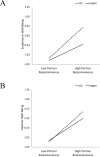Patterns of perceived partner responsiveness and well-being in Japan and the United States
- PMID: 29698009
- PMCID: PMC5922804
- DOI: 10.1037/fam0000378
Patterns of perceived partner responsiveness and well-being in Japan and the United States
Abstract
Quality of marital relationships is consistently linked to personal well-being. However, almost all of the studies linking marital processes to well-being have been conducted in Western (particularly North American) countries. Growing evidence shows that perceived partner responsiveness is a central relationship process predicting well-being in Western contexts but little is known about whether this association generalizes to other countries. The present work investigated whether the predictive role of perceived partner responsiveness in well-being differs across the United States and Japan-2 contexts with contrasting views on how the self is conceptualized in relation to the social group. A large life span sample of married or long-term cohabiting adults (n = 3,079, age range = 33-83 in the United States and n = 861, age range = 30-79 in Japan) completed measures of perceived partner responsiveness, hedonic and eudaimonic well-being, and demographic (age, gender, education) and personality (extraversion and neuroticism) covariates known to predict well-being. Perceived partner responsiveness positively predicted hedonic and eudaimonic well-being both in the U.S. and in Japan. However, perceived partner responsiveness more strongly predicted both types of well-being in the United States as compared with Japan. The difference in slopes across the 2 countries was greater for eudaimonic as compared with hedonic well-being. The interaction between perceived partner responsiveness and country held even after controlling for demographic factors and personality traits. By showing that the role of perceived partner responsiveness in well-being may be influenced by cultural context, our findings contribute to achieving a more nuanced picture of the role of relationships in personal well-being. (PsycINFO Database Record
(c) 2018 APA, all rights reserved).
Figures


Similar articles
-
Does Partner Responsiveness Predict Hedonic and Eudaimonic Well-Being? A 10-Year Longitudinal Study.J Marriage Fam. 2016 Apr;78(2):311-325. doi: 10.1111/jomf.12272. Epub 2015 Dec 17. J Marriage Fam. 2016. PMID: 28592909 Free PMC article.
-
Perceived Partner Responsiveness Mediates the Association Between Sexual and Marital Satisfaction: A Daily Diary Study in Newlywed Couples.Arch Sex Behav. 2016 Jan;45(1):109-20. doi: 10.1007/s10508-014-0448-2. Epub 2015 Feb 14. Arch Sex Behav. 2016. PMID: 25680818
-
Within-Couple Personality Concordance Over Time: The Importance of Personality Synchrony for Perceived Spousal Support.J Gerontol B Psychol Sci Soc Sci. 2021 Jan 1;76(1):31-43. doi: 10.1093/geronb/gbaa163. J Gerontol B Psychol Sci Soc Sci. 2021. PMID: 32931566 Free PMC article.
-
Personality disorder in marriage and partnership - a narrative review.Neuro Endocrinol Lett. 2018 Sep;39(3):159-171. Neuro Endocrinol Lett. 2018. PMID: 30431743 Review.
-
Responsiveness in cultural-ecological context.Curr Opin Psychol. 2023 Aug;52:101610. doi: 10.1016/j.copsyc.2023.101610. Epub 2023 Jun 1. Curr Opin Psychol. 2023. PMID: 37352794 Review.
Cited by
-
Aspects of Quality of Life: Single vs. Mated People.Behav Sci (Basel). 2024 Oct 16;14(10):954. doi: 10.3390/bs14100954. Behav Sci (Basel). 2024. PMID: 39457828 Free PMC article.
-
The Link between the Nature of the Human-Companion Animal Relationship and Well-Being Outcomes in Companion Animal Owners.Animals (Basel). 2024 Jan 29;14(3):441. doi: 10.3390/ani14030441. Animals (Basel). 2024. PMID: 38338084 Free PMC article.
-
The Effect of Emotional Reactivity on Marital Quality in Chinese Couples: The Mediating Role of Perceived Partner Responsiveness.Front Psychol. 2022 Jan 18;12:787899. doi: 10.3389/fpsyg.2021.787899. eCollection 2021. Front Psychol. 2022. PMID: 35115988 Free PMC article.
-
Maltreatment in Childhood and Perceived Partner Responsiveness in Adult Romantic Relationships: A Dyadic Daily Diary and Longitudinal Study.Child Maltreat. 2023 Feb;28(1):163-175. doi: 10.1177/10775595211057230. Epub 2021 Dec 5. Child Maltreat. 2023. PMID: 34866414 Free PMC article.
References
-
- Adams G, Anderson SL, Adonu JK. The cultural grounding of closeness and intimacy. In: Mashek DJ, Aron A, editors. The handbook of closeness and intimacy. Mahwah, NJ: Lawrence Erlbaum Associates; 2004. pp. 321–339.
-
- Beckes L, Coan JA. The distress-relief dynamic in attachment bonding. In: Zayas V, Hazan C, editors. Bases of adult attachment: Linking brain, mind and behavior. New York: Springer; 2015. pp. 11–33.
-
- Bowlby J. A secure base: Clinical applications of attachment theory. London: Routledge; 1988.
-
- Byrne BM, Shavelson RJ, Muthén B. Testing for the equivalence of factor covariance and mean structures: The issue of partial measurement invariance. Psychological Bulletin. 1989;105:456–466. doi: 10.1037/0033-2909.105.3.456. - DOI
-
- Chen FF. Sensitivity of goodness of fit indexes to lack of measurement invariance. Structural Equation Modeling. 2007;14:464–504. doi: 10.1080/10705510701301834. - DOI
MeSH terms
Grants and funding
LinkOut - more resources
Full Text Sources
Other Literature Sources

